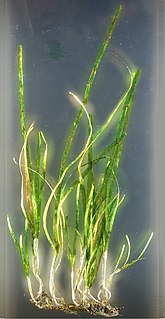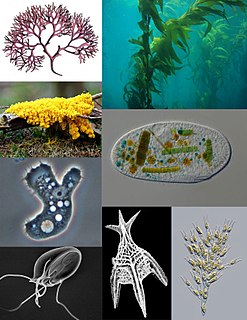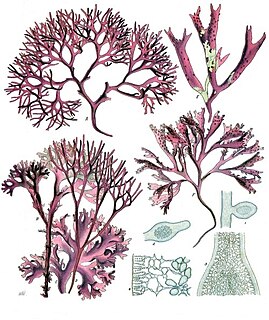
Algae is an informal term for a large and diverse group of photosynthetic eukaryotic organisms. It is a polyphyletic grouping that includes species from multiple distinct clades. Included organisms range from unicellular microalgae, such as Chlorella,Prototheca and the diatoms, to multicellular forms, such as the giant kelp, a large brown alga which may grow up to 50 metres (160 ft) in length. Most are aquatic and autotrophic and lack many of the distinct cell and tissue types, such as stomata, xylem and phloem that are found in land plants. The largest and most complex marine algae are called seaweeds, while the most complex freshwater forms are the Charophyta, a division of green algae which includes, for example, Spirogyra and stoneworts.

Stramenopile is a clade of organisms distinguished by the presence of stiff tripartite external hairs. In most species, the hairs are attached to flagella, in some they are attached to other areas of the cellular surface, and in some they have been secondarily lost. Stramenopiles represent one of the three major clades in the SAR supergroup, along with Alveolata and Rhizaria.
In biology, a kingdom is the second highest taxonomic rank, just below domain. Kingdoms are divided into smaller groups called phyla. Traditionally, some textbooks from the United States and Canada used a system of six kingdoms while textbooks in Great Britain, India, Greece, Brazil and other countries use five kingdoms only. Some recent classifications based on modern cladistics have explicitly abandoned the term kingdom, noting that some traditional kingdoms are not monophyletic, meaning that they do not consist of all the descendants of a common ancestor. The terms flora, fauna, and, in the 21st century, funga are also used for life present in a particular region or time.

An epiphyte is an organism that grows on the surface of a plant and derives its moisture and nutrients from the air, rain, water or from debris accumulating around it. The plants, on which epiphytes grow, are called phorophytes. Epiphytes take part in nutrient cycles and add to both the diversity and biomass of the ecosystem in which they occur, like any other organism. They are an important source of food for many species. Typically, the older parts of a plant will have more epiphytes growing on them. Epiphytes differ from parasites in that they grow on other plants for physical support and do not necessarily affect the host negatively. An organism that grows on another organism that is not a plant may be called an epibiont. Epiphytes are usually found in the temperate zone or in the tropics. Epiphyte species make good houseplants due to their minimal water and soil requirements. Epiphytes provide a rich and diverse habitat for other organisms including animals, fungi, bacteria, and myxomycetes.

The three-domain system is a biological classification introduced by Carl Woese, Otto Kandler and Mark Wheelis in 1990 that divides cellular life forms into three domains, namely Archaea, Bacteria, and Eukaryote or Eukarya. The key difference from earlier classifications such as the two-empire system and the five-kingdom classification is the splitting of archaea from bacteria as completely different organism. It has been challenged by the two-domain system that divides organisms into Bacteria and Archaea only, as eukaryotes are considered as one group of archaea.

Seagrasses are the only flowering plants which grow in marine environments. There are about 60 species of fully marine seagrasses which belong to four families, all in the order Alismatales. Seagrasses evolved from terrestrial plants which recolonised the ocean 70 to 100 million years ago.

The green algae are a group consisting of the Prasinodermophyta and its unnamed sister which contains the Chlorophyta and Charophyta/Streptophyta. The land plants (Embryophytes) have emerged deep in the Charophyte alga as sister of the Zygnematophyceae. Since the realization that the Embryophytes emerged within the green algae, some authors are starting to properly include them. The completed clade that includes both green algae and embryophytes is monophyletic and is referred to as the clade Viridiplantae and as the kingdom Plantae. The green algae include unicellular and colonial flagellates, most with two flagella per cell, as well as various colonial, coccoid and filamentous forms, and macroscopic, multicellular seaweeds. There are about 22,000 species of green algae. Many species live most of their lives as single cells, while other species form coenobia (colonies), long filaments, or highly differentiated macroscopic seaweeds.

Thomas (Tom) Cavalier-Smith, FRS, FRSC, NERC Professorial Fellow, was a Professor of Evolutionary Biology in the Department of Zoology, at the University of Oxford.

The Archaeplastida are a major group of eukaryotes, comprising the photoautotrophic red algae (Rhodophyta), green algae, land plants, and the minor group glaucophytes. It also includes the non-photosynthetic lineage Rhodelphidia, a predatorial (eukaryotrophic) flagellate that is sister to the Rhodophyta, and probably the microscopic picozoans. The Archaeplastida have chloroplasts that are surrounded by two membranes, suggesting that they were acquired directly through a single endosymbiosis event by feeding on a cyanobacterium. All other groups which have chloroplasts, besides the amoeboid genus Paulinella, have chloroplasts surrounded by three or four membranes, suggesting they were acquired secondarily from red or green algae. Unlike red and green algae, glaucophytes have never been involved in secondary endosymbiosis events.

A seagrass meadow or seagrass bed is an underwater ecosystem formed by seagrasses. Seagrasses are marine (saltwater) plants found in shallow coastal waters and in the brackish waters of estuaries. Seagrasses are flowering plants with stems and long green, grass-like leaves. They produce seeds and pollen and have roots and rhizomes which anchor them in seafloor sand.

Monera (/məˈnɪərə/) is a biological kingdom that is made up of prokaryotes. As such, it is composed of single-celled organisms that lack a nucleus.

A protist is any eukaryotic organism that is not an animal, plant, or fungus. While it is likely that protists share a common ancestor, the exclusion of other eukaryotes means that protists do not form a natural group, or clade. Therefore, some protists may be more closely related to animals, plants, or fungi than they are to other protists; however, like the groups algae, invertebrates, and protozoans, the biological category protist is used for convenience. Others classify any unicellular eukaryotic microorganism as a protist. The study of protists is termed protistology.

Red algae, or Rhodophyta, are one of the oldest groups of eukaryotic algae. The Rhodophyta also comprises one of the largest phyla of algae, containing over 7,000 currently recognized species with taxonomic revisions ongoing. The majority of species (6,793) are found in the Florideophyceae (class), and mostly consist of multicellular, marine algae, including many notable seaweeds. Red algae are abundant in marine habitats but are relatively rare in freshwaters. Approximately 5% of the red algae occur in freshwater environments with greater concentrations found in warmer areas. Except for two coastal cave dwelling species in the asexual class Cyanidiophyceae, there are no terrestrial species, which may be due to an evolutionary bottleneck where the last common ancestor lost about 25% of its core genes and much of its evolutionary plasticity.
The genus Labyrinthula is part of the protist group Labyrinthulomycetes and contains thirteen species. The major feature of this genus is the formation of an ectoplasmic net secreted by specialized organelles called bothrosomes which surrounds the colony, which is also used by Labyrinthula for moving. The protist reproduces by zoosporulation as it sets some flagellated spores free from a sporangium. Zoospores prove the belonging of Labyrinthula in the Heterokont phylum due to the distinct flagellar morphology, in which the anterior one is covered in mastigonemes.

Marine microorganisms are defined by their habitat as microorganisms living in a marine environment, that is, in the saltwater of a sea or ocean or the brackish water of a coastal estuary. A microorganism is any microscopic living organism or virus, that is too small to see with the unaided human eye without magnification. Microorganisms are very diverse. They can be single-celled or multicellular and include bacteria, archaea, viruses and most protozoa, as well as some fungi, algae, and animals, such as rotifers and copepods. Many macroscopic animals and plants have microscopic juvenile stages. Some microbiologists also classify biologically active entities such as viruses and viroids as microorganisms, but others consider these as non-living.

Blue carbon is carbon sequestration by the world's oceanic and coastal ecosystems, mostly by algae, seagrasses, macroalgae, mangroves, salt marshes and other plants in coastal wetlands. This occurs through plant growth and the accumulation and burial of organic matter in the soil. Because oceans cover 70% of the planet, ocean ecosystem restoration has the greatest blue carbon development potential. Research is ongoing, but in some cases it has been found that these types of ecosystems remove far more carbon than terrestrial forests, and store it for millennia.
The biological classification system of life introduced by British zoologist Thomas Cavalier-Smith involves systematic arrangements of all life forms on earth. Following and improving the classification systems introduced by Carl Linnaeus, Ernst Haeckel, Robert Whittaker, and Carl Woese, Cavalier-Smith's classification attempts to incorporate the latest developments in taxonomy. His classification has been a major foundation in modern taxonomy, particularly with revisions and reorganisations of kingdoms and phyla.
Neobodo are diverse protists belonging to the eukaryotic supergroup Excavata. They are Kinetoplastids in the subclass Bodonidae. They are small, free-living, heterotrophic flagellates with two flagella of unequal length used to create a propulsive current for feeding. As members of Kinetoplastids, they have an evident kinetoplast There was much confusion and debate within the class Kinetoplastid and subclass Bodonidae regarding the classification of the organism, but finally the new genera Neobodo was proposed by Keith Vickerman. Although they are one of the most common flagellates found in freshwater, they are also able to tolerate saltwater Their ability to alternate between both marine and freshwater environments in many parts of the world give them a “cosmopolitan” character. Due to their relatively microscopic size ranging between 4-12 microns, they are further distinguished as heterotrophic nanoflagellates. This small size ratio limits them as bacterivores that swim around feeding on bacteria attached to surfaces or in aggregates.

Marine primary production is the chemical synthesis in the ocean of organic compounds from atmospheric or dissolved carbon dioxide. It principally occurs through the process of photosynthesis, which uses light as its source of energy, but it also occurs through chemosynthesis, which uses the oxidation or reduction of inorganic chemical compounds as its source of energy. Almost all life on Earth relies directly or indirectly on primary production. The organisms responsible for primary production are called primary producers or autotrophs.

Marine protists are defined by their habitat as protists that live in marine environments, that is, in the saltwater of seas or oceans or the brackish water of coastal estuaries. Life originated as single-celled prokaryotes and later evolved into more complex eukaryotes. Eukaryotes are the more developed life forms known as plants, animals, fungi and protists. Protists are the eukaryotes that cannot be classified as plants, fungi or animals. They are usually single-celled and microscopic. The term protist came into use historically as a term of convenience for eukaryotes that cannot be strictly classified as plants, animals or fungi. They are not a part of modern cladistics, because they are paraphyletic.
















